Doom: The Dark Ages is set to release this May, but last week I had a chance to sit down for several hours to play the game on a high-end PC. What I can say and show is limited, but the latest modern Doom and its idTech 8 underpinnings already look hugely impressive. There’s plenty to praise here – as well as a few caveats that are worth bringing up.
First, the engine. Machine Games’ Indiana Jones showed just how capable modern versions of idTech have become, and The Dark Ages shares the same extremely realistic visuals – albeit in starkly different setting. Everything feels alive, with a tremendous amount of secondary animation – blowing trees and flags and pouring rain and storm clouds.
Though I didn’t get a chance to see the game at max settings – or in its upcoming path tracing mode – the game was running with standard RT enabled, including RT reflections (like Doom Eternal) and RTGI (like Indiana Jones). This looks nice, with more watery levels showing off full RT reflections with atmospherics layered on using SSR. There are plenty of reflective surfaces around despite the move to more naturalistic environments, but it’s precisely that shift in tone that allows the RTGI to shine. This enables much more accurate and dramatic lighting across a huge space that’s almost entirely lit by natural sources like flames and the sun.
It works well, as it did in Indiana Jones, but there’s more of a focus here on destructible, physics-driven dynamic objects. Eliminating baked lighting means that these objects can blend more seamlessly into the environment, and allows for Crysis-style destruction that was absent from the prior two games. Wooden structures can be blasted away until they buckle under their own weight, leaving remnants that can be hacked at further to separate them into even smaller pieces. This makes arenas in the game feel much more active, with things changing and structures breaking apart as you engage enemies. Later sequences with a huge Doom mech take this even further, as you can stomp around destroying a massive city environment – very cool.
There are also more realistic water effects, such as proper geometric ripples when you run through a body of water that nicely complement the RT reflections. You also get an interesting effect when swimming below the surface which I liked quite a bit.
There also seems to be a virtualised geometry system similar to Unreal’s Nanite, though I can’t actually confirm this yet. In short, you won’t see big chunks of the scene changing in terms of visual complexity as you move through the world, with more seamless changes that avoid noticeable pop-in. That said, this doesn’t seem to work with grass and certain types of foliage, but it’s still an interesting development – and hopefully one we get more detail on in the final game.
Apart from the level geometry itself, the number of on-screen enemies has increased dramatically – to levels unseen since the original sprite-based Doom games. Right at the beginning of a mission, for example, I counted more than 30 on-screen enemies, with more appearing as you fight. It’s wild to consider that idTech 8 is able to handle dozens of enemies in this manner while also delivering a world with virtualised geometry, full RT lighting and reflections and robust physics simulation, all while targeting 60fps. I haven’t played the game on consoles, but knowing id’s prior work I have full confidence they’ll get it to 60fps. The point is that The Dark Ages combines cutting-edge tech with very high levels of performance. How high remains to be seen, but this demo suggests we’re in for a real treat.
Beyond the tech and visuals, it’s worth underlining how different the game plays to Doom (2016) and Doom Eternal. In the latter game, as you progress, battles can become quite long, often locking players into a single space as enemies pour in until you reach an arbitrary level of destruction that allows further progress. You spend a lot of time watching cool-down metres for various power-ups, and you need to leverage the glory kill and chainsaw systems to keep your health and ammo topped up – so you’re watching these animations again and again, relinquishing control. I love the movement and flow of the game, but there are some issues with pacing that stood out.
In Doom: The Dark Ages, this has changed completely. Smaller foes go down much quicker, sometimes in a single shot or two, though they’re still viable threats that can eat away your health. You can also take out multiple opponents at once, eg with the shield that can crash into a mob and explode. Glory kills have been almost completely eliminated from normal enemies, with similar prompts that can appear but don’t take control away from the player. Only in rare instances do you get the full glory kill experience, and normally it’s deployed on big bosses – to the point that I don’t think the term is even used any more. Similarly, chainsawing enemies is not necessary for regaining ammo.
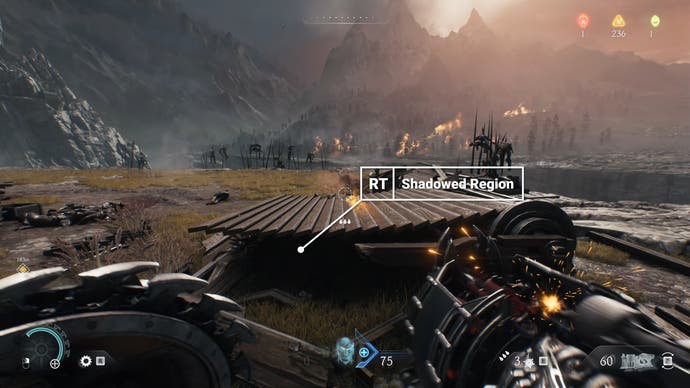
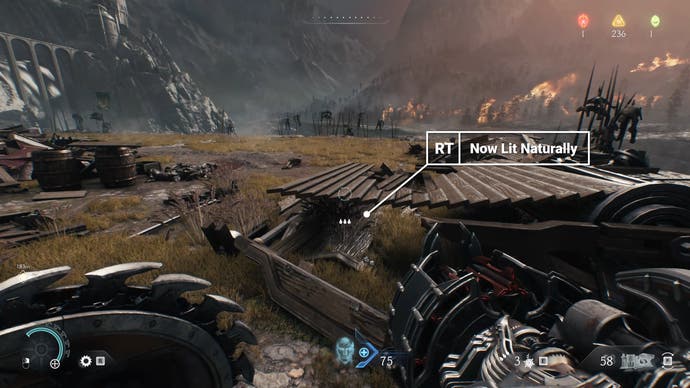
As a result of these changes, battles flow more smoothly. You’ll need to change your strategy against different enemy types, but you don’t lose control as in Doom Eternal. It actually feels like a marriage between classic Doom and modern Doom combat, which really impressed me. Similarly, abilities available on a cool-down feel more optional, though they’re fun to use, and the game feels more free-form. There are fewer moments where you’re trapped in a room, and you’re able to sprint past some enemies – though they may follow you or simply stick around to trouble you the next time you enter a given area. One thing that doesn’t really return is aerial moves and platforming, which is minimised here.
The shield mechanics are also very interesting. You can bash enemies, throw your shield in combat or to solve puzzles, and there’s also a block and parry system which doesn’t feel obligatory but is fun to use. Some parts remind me of Returnal, with enemies shooting particles you can parry back, but it’s not a scripted animation and you retain control.
The options menu is also incredible, with settings to dial in gameplay exactly the way you like it. You can adjust things like game speed, enemy agression, particle speed and so on. I played most of the demo at 150 percent speed and had a blast.
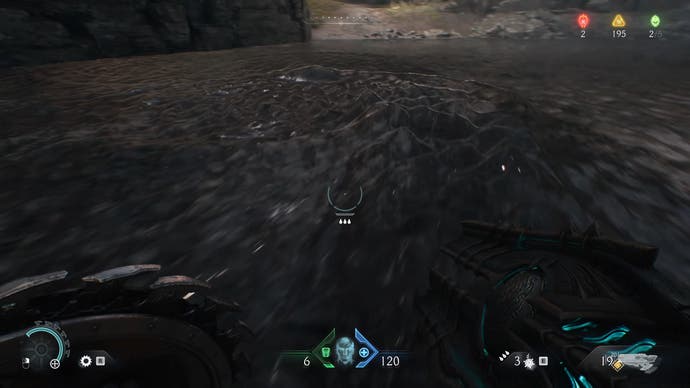
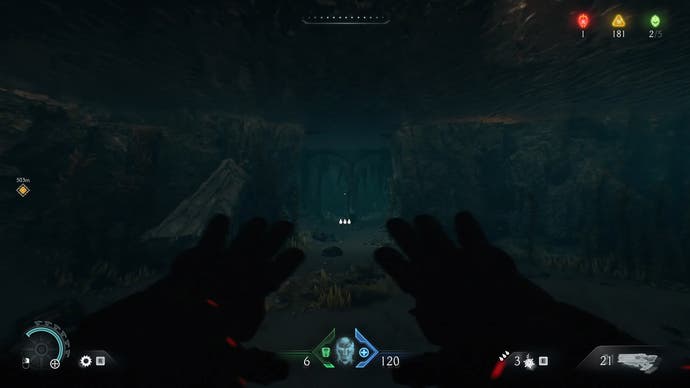
The game also changes quite a bit from level to level. The opening stage, which I couldn’t capture, had a classic Doom gameplay loop – all about finding keycards to unlock new areas – and it still works well. There are also mech levels, where you’re smashing city buildings and fighting giant demons. I don’t kow how often these will appear in the game, but I enjoyed the sequences quite a bit. There are also dragon missions, where you can fly around freely in 3D space, locking onto and destroying enemies, or land to fight on foot for a while. It reminds me of vehicle missions in Halo or Titanfall 2. There’s also a large open map. Marketing materials deliberately don’t say “open world”, and that feels fair – it’s a larger level with objectives, bonus encounters, collectibles and even new weapons scattered around for the player to find.
I still have a lot of questions about how the game will play out. There seems to be more of a focus on story here, with cutscenes at the beginning and end of missions I played. This is not The Last of Us by any stretch, and it’s all action-orientated, but I did play is super promising.
I do have some nitpicks about certain elements of the game as I played. For example, due to the focus on shield mechanics, there’s no option to have a centred weapon in the classic Doom style. There’s also no dot crosshair, which I prefer. The soundtrack also doesn’t quite hit the highs of the Doom and Doom Eternal, with quite good individual tracks that don’t seem to have as much impact while actually playing the game.
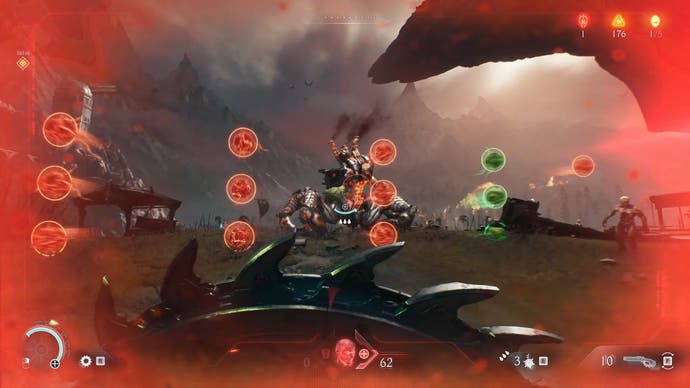
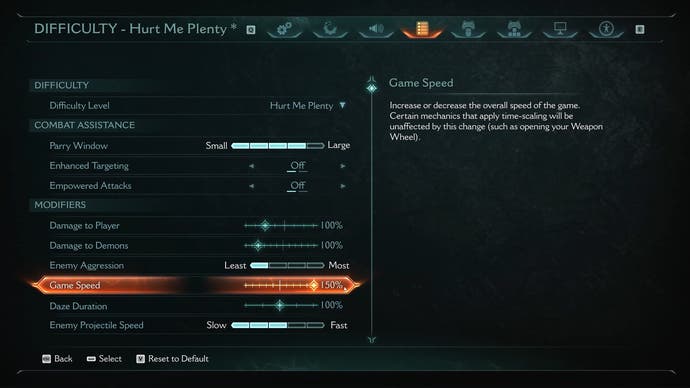
Another minor complaint is the intensity of the colours of powerups, which obviously need to be easy to spot for gameplay reasons, but perhaps could be optionally toned down to better mesh with the environment. The entire screen staying red while your health drops below a certain level is also annoying. Thankfully, the HUD does have one awesome touch: a kind of simulation of the original Doom guy, complete with low frame-rate animation.
Lastly, this is a weird complaint, but the game loads so fast on PC that the loading screens feel a bit pointless – even faster than Doom (2016), which is just wild. Therefore, having an option to disable loading screens entirely and just dip to black might make sense rather than requiring a key press after a second or two.
Overall though, I hugely enjoyed my time with Doom: The Dark Ages, and while I still have some questions and concerns, this has a good chance of becoming the best of the three recent Doom titles. I guess we’ll have to wait until May to be sure.
Source link










Add comment